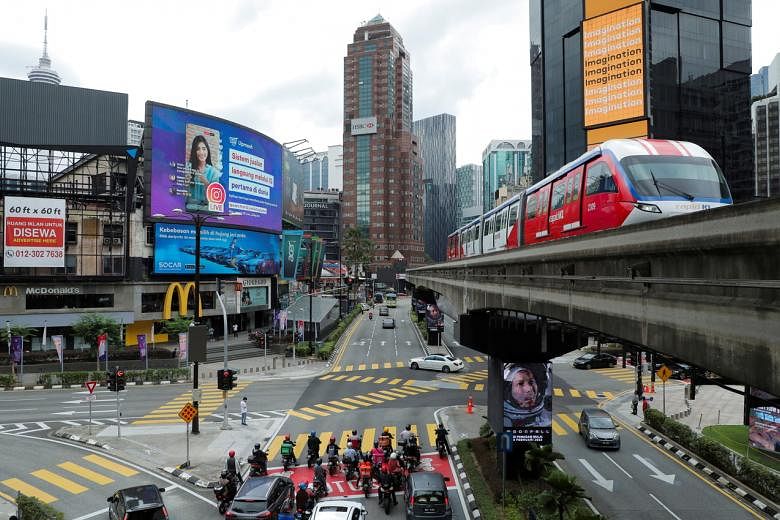KUALA LUMPUR - Hundreds of salarymen queueing daily for a cheap lunch of laksa may have seen the last of sole breadwinner Rohkiah Abdul Aziz's stall in Sungai Buloh near Malaysia's capital Kuala Lumpur.
Having barely survived the Covid-19 pandemic, 41-year-old Madam Rohkiah, whose husband is disabled, is at her wits' end after the worst flood in a century destroyed her two cars, kitchen and laksa cart. Persistent inflation in the past year has left her with no means to restart her business.
"Everything, especially food, is so expensive. Now I'm left with nothing in my bank account and no way to get back on my feet," she said.
Such bleak stories from the ground at the start of the year are in stark contrast to the optimism from policymakers that 2022 will be the year of recovery - they said that for 2021 too - for Malaysia's economy.
Unemployment is at its lowest since the pandemic began, manufacturing and mining production is up and wholesale and retail trade is at a record peak.
"We can see clear momentum for economic growth," Finance Minister Tengku Zafrul Aziz told state television on Tuesday (Jan 18), adding that the government projected growth of up to 6.5 per cent this year.
However, these positive indicators came in November, right after Malaysia unleashed pent-up demand by exiting its Covid-19 lockdown, but before the month-long floods and the coronavirus cases inching up due to the hyper-infectious Omicron variant.
Datuk Seri Zafrul did highlight the government's efforts to ease the sting of the twin disasters and its billion-ringgit measures will no doubt help many to keep their heads above water. But the speed bumps ahead remain the same as those of the past two years - depressed spending coupled with rising prices.
Private consumption dropped 4.3 per cent in 2020 and only inched up 1.2 per cent from January to September last year despite the low base. Employees Provident Fund (EPF) data also showed that median salaries as at mid-last year had regressed by three years.
The hesitancy to spend left consumption weak despite household loans continuing to grow. This helped accelerate savings growth. The RM226 billion (S$72.6 billion) in savings accounts is over 40 per cent more than 2019's level.
"When purchasing power is dampened, it will slow down the recovery. Many are also being cautious and making sure they have contingency funds," Socio-Economic Research Centre (Serc) executive director Lee Heng Guie told The Straits Times.
Despite this, inflation is expected to come in at 2.5 per cent for last year, the second-highest level since 2015, and economists believe the level will persist this year. A key culprit is supply chain disruptions, leading to cost spikes. The flooding has also dampened production of goods, especially food.
This "stagflation" risk comes as the nation, gripped by political instability as much as by the pandemic over the past two years, tries to claw back about a 10 per cent gap between its current gross domestic product and the projected level.
"This represents a permanent loss of output," EPF chief strategist Nurhisham Hussein said at the ISEAS - Yusof Ishak Regional Outlook Forum 2022 this month. "What's driving the recovery is primarily exports. But imports have not recovered as much, implying the domestic economy continues to be fairly weak and that's borne out by EPF's data on median salary."
Last year's trade surplus up to November is a fifth more than the whole of 2020, which was already the highest-ever. Yet 2020 saw gross domestic product shrink by 5.6 per cent, and last year's growth is expected to come in below 4 per cent.
This was partly due to Malaysia's growth trend since the mid-2000s being driven largely by retail trade - basically shopping, said Mr Nurhisham - and last November's retail trade bump notwithstanding, consumer sentiment does not seem to be improving.
Serc's Mr Lee believes "inflation is a prime risk because if corporates preserve margins, then consumers suffer, or vice versa. And we know inflation has an uneven impact, with some on the ground saying their costs are up as much as 10 per cent".
It is a tough balancing act even for small traders like Mr Panir Selvam Muniandy, who has for decades catered to workers seeking an affordable Indian lunch in Kuala Lumpur suburb Bangsar. He was forced into a hiatus of more than a month due to the floods.
"Cooking oil, milk, potatoes, you name it, some items have gone up by 200 per cent," he told ST.
"But my customers are all my friends, and it would be cruel to raise prices of a basic meal. A lot of them have taken pay cuts but prices are going up. So I don't know what kind of economic recovery we are talking about."


